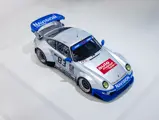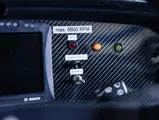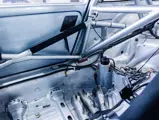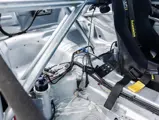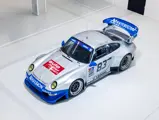Monaco
1998 Porsche 911 GT2 by Roock Racing
{{lr.item.text}}
€750,000 - €1,000,000 EUR | Not Sold
 | Monaco, Monaco
| Monaco, Monaco
{{internetCurrentBid}}
{{internetTimeLeft}}

- One of just six 911 GT2 Evolutions constructed by Roock Racing, using lightweight and reinforced monocoque chassis supplied by Porsche
- Contested all 10 rounds of the 1998 FIA GT Championship, achieving four top-six class finishes
- Finished 7th overall and 1st in the GT2 class in the 1999 Daytona 24 Hours
- Competed in a further five FIA GT and six ALMS rounds across the 1999 and 2000 seasons, including the 1999 Petit Le Mans and 2000 Sebring 12 Hours
- Later entered into the 1999 24 Hours of Le Mans; where it was driven by Hubert Haupt, John Robinson, and Hugh Price
- Driven by Porsche luminaries Sascha Maassen, Claudia Hürtgen and 1998 Le Mans winner Stéphane Ortelli
- Offered directly from the collection of its Daytona-winning driver, Hubert Haupt
- Ideally suited to the historic racing events it is eligible for
Ever since their respective international debuts in the 1995 BPR Global GT Series, Roock Racing and Porsche’s 911 GT2 model have been synonymous. Although the Leverkusen-based squad did occasionally compete in the top-flight GT1 class against the likes of the McLaren F1 and the Ferrari F40, it was in GT2 that the team forged its reputation; a fact underlined by two class wins at the Daytona 24 Hours, and one at Le Mans.
Initially launched with a 3.6-litre Type-M64/81 engine, the 911 GT2 produced 450 horsepower in GT2 specification and 550 horsepower when configured for GT1. However, the introduction of the lightweight 911 GT2 Evolution in 1996—intended for GT1, boasting almost 600 horsepower and weighing barely 1,100 kilograms—provided Roock with the basis for a hugely potent GT2 variant.
Constructed around an extensively lightened, Porsche-supplied GT2 monocoque chassis, Roock extended the roll cage forwards into the fuel cell area, thereby strengthening the car’s front end considerably. A twin-plug, six-coil Type-M64/83 engine was fitted; its revised KKK turbochargers now boosting power to some 580 horsepower, with the entire transmission uprated accordingly. All carbon fibre bodywork accommodated a track widened by some seven centimetres, while bespoke Moton dampers were employed to cope with the increased cornering loads. At 1,060 kilograms, Roock had produced the lightest 911 GT2 variant yet seen, and just six such cars—sequentially numbered RST 530 001 to 530 006—were constructed.
Duly completed for the 1998 race season, Roock’s primary focus with RST 530 003—the car offered here—was that year’s FIA GT Championship; the FIA-sanctioned successor to the BPR series. Driven by former Daytona 24 Hours podium finisher André Ahrlé and Thai GT regular Ratanakul Prutirat, the season commenced solidly, with top-10 finishes in the GT2 class at Oschersleben, Silverstone, and Dijon-Prenois. However, July’s round at the Hungaroring brought with it a marked improvement, and the pair were rewarded by a creditable 11th place overall and 6th in GT2.
If consecutive non-finishes in the mid-season Suzuka and Donington rounds proved a disappointment, then the North American conclusion to the season was overwhelmingly positive. At Homestead in October, Ahrlé and future Corvette Racing star Andy Pilgrim recorded a fine 12th overall and 5th in GT2, while the final round of the Championship at Laguna Seca saw a superb 10th overall and 4th in class for the German and stand-in co-drivers Rob Schirle and Dirk Layer.
In late 1998, chassis 003 was sold to former Saleen works driver David Warnock, who had piloted Roock’s sister 993-gen GT2 at the Le Mans 24 Hours only months earlier. Having failed to finish the Daytona 24 Hours in 1997, the Briton vowed to return in 1999; the team duly assembling a strong driver line-up comprising Ahrlé, former Audi DTM driver Hubert Haupt, experienced Porsche GT racer Raffaele Sangiuolo, and Warnock himself. After qualifying an encouraging 28th out of 78 starters, chassis 003 was driven to a near-faultless race, eventually finishing 7th overall, 1st in the GT2 class, and some eight laps clear of the nearest class opposition.
Its American sojourn completed, the car returned to Europe for the start of the FIA GT Championship; the series having transitioned to a single-class, GT2-only format over the winter. Roock stalwart Claudia Hürtgen and 1998 Le Mans winner Stéphane Ortelli were retained to drive, the pair finishing 8th at Monza and 5th at Silverstone. However, domination of the Championship by the factory-entered Chrysler Vipers precipitated a mid-season switch for chassis 003 to the American Le Mans Series, with September’s Petit Le Mans at Road Atlanta the team’s first target. Returning Daytona winners Haupt and Ahrlé joined Hürtgen in the car; the trio finishing in 26th position overall, and 7th in the GTS class. Thereafter Ahrlé and Hürtgen contested the final two rounds of the series; the shorter format races yielding fine 4th-in-class finishes at both Laguna Seca and Las Vegas. In 1999, the Porsche was driven in the 24 Hours of Le Mans by Hubert Haupt, John Robinson, and Hugh Price. The car didn't finish the race due to an engine problem.
The new millennium saw chassis 003 return to Daytona for a second time, although on this occasion its race ended after 10 hours with engine failure; similar problems also blighting the car’s maiden Sebring 12 Hours. Ironically, the car’s final two ALMS appearances—at Charlotte in April, and at the fly-away Nürburgring 1000 Kilometres in July—yielded its best ever results; Vic Rice and current McLaren CEO Zak Brown finishing 2nd in the GTS class at the former and, aided by the returning Haupt, 3rd in Germany.
Some time after the conclusion of its contemporary racing career, chassis 003 was acquired by prominent Porsche collector Francis Boodts of Les Issambres, France. It remained in his ownership until 2011 when, fittingly, it was purchased by Hubert Haupt himself. In 2012, Herr Haupt entrusted chassis 003 to his—and the car’s—erstwhile team for a comprehensive overhaul; the work performed including a complete engine rebuild, incorporating new pistons and cylinders, a full brake and air jack system overhaul and the fitment of a new power steering pump and bladder-type fuel cell (since expired). Additionally, in 2018, the car was subjected to a full bodily restoration, which included reinstating the exact livery used in its victorious 1999 Daytona campaign.
Offering tremendous rarity, spectacular performance, an illustrious competition history and impeccable provenance, chassis 003 undoubtedly represents one of the most significant non-factory Porsche GT cars offered for sale in recent years. Furthermore, its eligibility for some of the world’s most exclusive historic racing events and enhanced practicality cement its undoubted status as a modern-generation endurance racing great; one worthy of inclusion in any appropriately discerning competition car collection.










